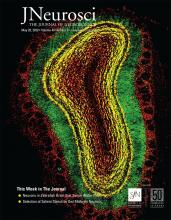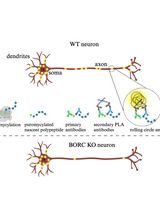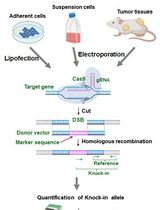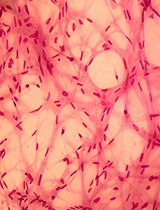- EN - English
- CN - 中文
Single or Repeated Ablation of Mouse Olfactory Epithelium by Methimazole
甲巯咪唑单次或多次消融小鼠嗅上皮细胞
发布: 2021年04月20日第11卷第8期 DOI: 10.21769/BioProtoc.3983 浏览次数: 5998
评审: Oneil Girish BhalalaAllan-Hermann PoolHSIU CHUN CHUANG
Abstract
Odor-detecting olfactory sensory neurons residing in the nasal olfactory epithelium (OE) are the only neurons in direct contact with the external environment. As a result, these neurons are subjected to chemical, physical, and infectious insults, which may be the underlying reason why neurogenesis occurs in the OE of adult mammals. This feature makes the OE a useful model for studying neurogenesis and neuronal differentiation, with the possibility for systemic as well as local administration of various compounds and infectious agents that may interfere with these cellular processes. Several different chemical compounds have been shown to cause toxic injury to the OE, which can be used for OE ablation. We, and others, have found that the systemic administration of the hyperthyroid drug, methimazole, reliably causes olfactotoxicity as a side effect. Here, we outline an OE lesioning protocol for single or repeated ablation by methimazole. A single methimazole administration can be used to study neuroepithelial regeneration and stem cell activation, while repeated ablation and regeneration of OE enable the study of tissue stem cell exhaustion and generation of tissue metaplasia.
Keywords: Olfactory epithelium (嗅觉上皮细胞)Background
New neurons are generated throughout life in the OE of mammals including humans (Hahn et al., 2005) and mice (Graziadei et al., 1979b; Kondo et al., 2010). Continuous cell generation is primarily achieved by globose progenitor cells (Jang et al., 2014). Progenitor cells also have the potential to reconstitute all OE cell types after injury, with horizontal basal cells having the greatest tissue stem cell potential (Leung et al., 2007; Schnittke et al., 2015; Gadye et al., 2017).
There exist different methods to specifically injure the OE in laboratory rodents, which in turn allows the study of the regenerative process including stem cell activation, neurogenesis, and neuronal differentiation. Methods include removal of the olfactory bulb (OB) (Schwob et al., 1992), olfactory nerve axotomy (Graziadei et al., 1979a; Suzuki and Takeda, 1991), intranasal administration of zinc sulphate (Matulionis, 1975), inhalation of methyl bromide gas (Hurtt et al., 1988), and intraperitoneal (i.p.) injection of olfactotoxic chemicals such as methimazole, colchicine, and dichlobenil (Genter et al., 1995; Suzuki et al.,1998; Bergman and Brittebo, 1999). All these methods induce the destruction of one or several OE cell types followed by detachment of the OE and subsequent regeneration. The mechanism of action differs depending on the method; thus, there are important differences regarding which cell types are affected and how. Noteworthy, viruses such as SARS-Cov-2 can also specifically damage OE cells (Zhang et al., 2020).
Methimazole (1-methyl-2-mercaptoimidazole, also called thiamazole) is used to treat hyperthyroidism (Astwood et al., 1945) and is known to cause a loss of the sense of smell (olfaction) as a side effect of treatment (Cooper, 1999). The OE is a pseudostratified epithelium in which all mature cells and horizontal basal cells are in contact with the basal lamina. In response to i.p. methimazole, several cell types in the OE, such as Bowman’s gland cells, sustentacular cells, and olfactory sensory neurons, display swollen organelles within four hours, which is followed by detachment of cells from the basal lamina (Bergström et al., 2003). After methimazole injury, the OE completely regenerates in approximately one month, and the first olfactory sensory neurons begin to make synaptic contacts with the OB at approximately 1–2 weeks (Suzukawa et al., 2011). Methimazole has been shown to affect young and aged mice differently, on postnatal day 10 compared with 18 months old (Suzukawa et al., 2011).
In rats, i.p. methimazole doses from 25 mg/kg to 300 mg/kg have been evaluated for OE toxicity (Genter et al., 1995). We conducted a pilot study to elucidate the lowest dose suitable for reproducible OE ablation in mice (Håglin et al., 2020). Single injection of either 75 mg/kg or 100 mg/kg resulted in detachment of the entire OE, whereas 50 mg/kg caused incomplete lesioning since there were residual patches of OE cells that appeared relatively unaffected. These results are in accordance with those of previous studies showing that lower doses of i.p. methimazole are insufficient to obtain complete OE lesions in mice (Brittebo, 1995) or rats (Genter et al., 1995). Since 75 mg/kg and 100 mg/kg yielded similar results, we used the lower dose for further studies.
In our hands, methimazole more reliably causes OE ablation than does dichlobenil, and in practice, methimazole is easier to use than zinc sulphate or methyl bromide gas. Our protocol is the first to describe repeated OE ablation–regeneration cycles. By repeating the injury up to three times, we found a gradual decrease in the regenerative potential of the OE, which is accompanied by the progressive accumulation of two different types of metaplasia (Håglin et al., 2020). Thus, repeated ablation–regeneration cycles of the mouse OE following methimazole treatment may be used, for example, to study: i) the exhaustion of the regenerative capacity of neurogenic tissue stem cells, which may mimic aging; ii) the robustness of the re-establishment of a tissue niche when subjected to repeated injury; iii) the plasticity of target neurons in the OB when challenged to re-establish synapses several times over; iv) the role of OE barrier function in protecting against a nasal route of infection as well as uptake of chemical substances to the brain; and v) the roles of different normal and disease variants of genes in these processes since there are many genetically modified mice available for study.
Materials and Reagents
50 ml plastic, conical-base centrifuge tubes with screw cap (Sarstedt, catalog number: 62.547.254 )
2 ml sterile plastic microcentrifuge tubes with snap cap (Eppendorf 022363433, Fisher Scientific, catalog number: 05-402-11 )
Micropipettes with appropriate tips
0.5–1 ml insulin syringe (for example Beckton-Dickinson, catalog number: 329651 ) with 27G × 13 mm needle (BD, catalog number: 300635 ) or 0.5 ml syringe with attached 29G × 13 mm needle (BD, catalog number: 323001 )
100 ml and 250 ml glass bottles (VWR, catalog numbers: 10754-814 and 10754-816 )
Permanent marker (please use one that withstands ethanol and freezing, such as the black Science-Marker VWR, catalog number: 76276-060 )
Peel-A-way® embedding molds (Sigma-Aldrich, catalog number: E6032-1CS )
Superfrost Plus microscope slides (Thermo Fisher Scientific, catalog number: 12727307 )
Cover slips no. 1 1/2 (Sigma-Aldrich, catalog number: CLS2980224-1000EA )
Boxes for microscope slides (VWR, catalog number: 82024-584 )
Mice of the strain, genotype, age, and sex that you wish to analyze. See Procedure A for the protocol for C57BL/6 mice (Taconic, Denmark)
Methimazole (Sigma-Aldrich, catalog number: M8506 ), keep the container closed in a dry and well-ventilated area. Store at 4 °C
Sterile physiological saline 9 mg/ml (e.g., Estericlean, catalog number: 7053249369080 )
Paraformaldehyde (VWR, catalog number: 28794 .295). Store the powder at 4 °C
Sucrose (VWR, catalog number: 27480 .294)
10× phosphate-buffered saline (PBS), pH 7.4 (e.g., PanReac Applichem, catalog number: A0965,9010 ). Dissolve and store at room temperature
5 M NaOH (VWR, catalog number: 31625 .293)
OCT cryomount embedding medium (Sakura FineTek, catalog number: 45830 )
Dry ice
Glycerol (VWR, catalog number: BDH1172-1LP )
Hoechst 33258 (Sigma-Aldrich, catalog number: ab228550 ). Prepare a 1000× stock solution of 0.5% (weight/volume) in water. Store the aliquots at –20 °C
Primary antibodies used to identify cell types in Figures 1 and 3 are:
Anti-cytokeratin 5 for horizontal basal cells (rabbit; dilution 1:300, BioLegend, catalog number: 905501 )
Anti-IgGFc-binding protein (FcγBP) for respiratory secretory cells (rabbit, dilution 1:200, Novus Biologicals, catalog number: NBP1-90462 )
Anti-antigen Ki-67 (Ki-67) for cells in the cell cycle (rabbit, 1:500, Merck, catalog number: AB9076 )
Anti-olfactory marker protein (OMP) for mature olfactory sensory neurons (goat; dilution 1:1,000, Wako Chemicals, catalog number: 544-10001 )
Anti-retinalaldehyde dehydrogenase type 1/2 (RALDH1/2) for supporting and respiratory cells (mouse; dilution 1:1,000, Santa Cruz Biotechnology, catalog number: SC-166362)
Anti-stathmin-1 (STMN1) for immature olfactory sensory neurons (rabbit; dilution 1:500, Abcam, catalog number: ab24445 )
Equipment
Dissection instruments
Scissors around 15 cm (Fine Science Tools, catalog number: 14001-14 ) and 10 cm (Fine Science Tools, catalog number: 14370-22 ) for the removal of fur and cutting through bone, respectively (expensive scissors will be destroyed)
A smaller pair of fine scissors for trimming soft tissue (preferably blunt tip, Fine Science Tools, catalog number: 14108-09 )
A few forceps, such as the fine pointed ones that are used to remove the teeth (Fine Science Tools, catalog number: 11231-30 ), blunt ones (Fine Science Tools, catalog number: 11000-12 ), and ones with teeth (Fine Science Tools, catalog number: 11028-15 ). Use blunt plastic forceps to check for decalcification (Fine Science Tools, catalog number: 11700-03 )
RDO Rapid Decalcifier (ApexEngineering directly www.rdodecal.com/contact/ or ESBE Scientific, catalog number: APE-RDOL4L )
Precision laboratory scale and analytical balance (for chemicals)
Precision laboratory scale (for mice)
Rocking platform or orbital shaker
Magnetic stirrer
Microwave oven
Cryostat with a knife for hard tissue
Inverted fluorescence microscope with camera and ×4, ×10, ×20 and ×40 objectives. A filter for fluorescence in blue (Hoechst 33258 is excited by light at 350 nm and emits at around 455 nm) is required at the least
–80°C freezer
Optional: Vacuum chamber or vacuum oven
Procedure
文章信息
版权信息
© 2021 The Authors; exclusive licensee Bio-protocol LLC.
如何引用
Readers should cite both the Bio-protocol article and the original research article where this protocol was used:
- Håglin, S., Bohm, S. and Berghard, A. (2021). Single or Repeated Ablation of Mouse Olfactory Epithelium by Methimazole. Bio-protocol 11(8): e3983. DOI: 10.21769/BioProtoc.3983.
- Håglin, S., Berghard, A. and Bohm, S. (2020). Increased retinoic acid catabolism in olfactory sensory neurons activates dormant tissue-specific stem cells and accelerates age-related metaplasia. J Neurosci 40(21): 4116-4129.
分类
神经科学 > 感觉和运动系统
干细胞 > 多能干细胞 > 再生医学
生物科学 > 生物技术 > 微生物技术
您对这篇实验方法有问题吗?
在此处发布您的问题,我们将邀请本文作者来回答。同时,我们会将您的问题发布到Bio-protocol Exchange,以便寻求社区成员的帮助。
Share
Bluesky
X
Copy link












